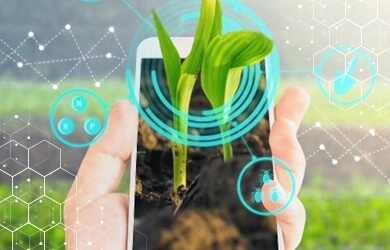Most Promising Agritech Trends to Watch Out for in 2022

Over the last few years, agritech has been steadily rising to the fore, solving critical challenges in the agricultural industry. From addressing climate change, encouraging precision agriculture, to even conducting more sustainable practices, agritech has been the driving force behind all these changes. And with growing technological innovations and advancements, we are set to witness even more valuable tech-driven solutions this year.
The use of agribots and artificial intelligence (AI) based machinery is expected to be adopted by a large sum of agribusinesses across the globe. Maps and geo-tagging for assessing plot-wise productivity and eliminating pests are quickly emerging as great solutions for agro-enterprises. Similarly, moving to indoor farming and making more data-driven decisions are also trends that agribusinesses must not miss out on in 2022.
Do you wish to stay abreast with the latest agritech trends in agriculture? Read on to know.
More Reliance on Data-driven Agriculture
Uncertainties in agricultural outcomes are pretty common. This is primarily due to the varying climate conditions, unavailability of resources, etc. As a result, the need for data-driven farming is growing across the world rapidly today. Data-driven farming has become very popular as it allows farmers to make informed decisions with respect to their farms and business.
Insights into how, where, and what to plant can be instrumental in refining the processes and driving highly profitable yields. This is the reason why every year, more and more agricultural producers across the world incorporate agritech elements into their agribusiness so as to reap the benefits of data-driven farming. 2022 would be no exception, witnessing the shift of a large number of farmers towards data-driven agriculture.
Replacing Labourers With Agricultural Robots
When it comes to large plantations or widely-spread farms, a major concern is labour management. Allocating, tracking, and assessing the activities of farm workers can be quite challenging. A great solution to this issue can be the use of agricultural robots. Many agribusinesses today, especially large farms and plantation managers, have thus replaced their labourers with highly efficient agricultural robots.
Agricultural robots assist farmers with various farm operations, including seeding, fertilisation, spraying, irrigation, harvesting, etc. One of the biggest benefits of such robots is that they let farmers automate various repetitive and mundane farm tasks. The use of robots is also enabling food producers to focus on more strategic farm functions. As a result, agricultural producers across the world will soon latch onto this trend and improve their outcomes with the help of robots.
Increased Utilisation of AI-Powered Machinery
With advancements in tools and technologies, the agriculture industry is witnessing new, more powerful equipment that are streamlining various agricultural processes. In today’s dynamic and fast-paced global landscape, having such machinery has become imperative for agribusinesses to stay relevant. The use of artificial intelligence-powered solutions offers enterprises predictive insights into various facets of their business.
AI-driven tools and machinery are making agricultural solutions much more personalised to suit the specific needs of agribusinesses. This customisation element is helping agribusiness owners level up their farm activities and generate outstanding agricultural outcomes consistently. As a result, more and more agribusinesses are incorporating AI-powered machinery and equipment into their farms and significantly expediting their farm operations.
Maps-based Pest Management and Productivity Analysis
Agribusinesses and farm enterprises around the world struggle with pest and disease management. With lack of proper pest management measures, farmers have a hard time protecting their crops from pests and diseases. Similarly, assessing and identifying the best plots in terms of productivity can also be extremely difficult for agribusinesses.
With the help of geo-tagging and maps feature, agri experts from any part of the world can inspect pests and offer useful solutions to mitigate them. Details such as pest’s category, exact location on the farm, and other information can also be made available through a map. Furthermore, geotagging can also enable agribusinesses to track the labour activities, machinery allocation, and final outcomes to evaluate the performance of each and every plot of their farm. Hence, pest management and productivity assessment through maps is a trend that agribusinesses must not miss out on in 2022.
Shift to Indoor Farming
With the ever-increasing global population, the demand for food is also skyrocketing. However, meeting this increasing food demand is not as easy as it seems. Owing to climate uncertainty and the growing unavailability of arable land, producing good quality crops consistently has become a huge challenge. Farmers in different parts of the world are thus making a shift to hydroponics/ indoor farming.
Indoor farming is not only eliminating the concern of unfavourable conditions and arable land unavailability but also empowering growers to produce top-quality crops all round the year. With this controlled environment agriculture (CEA) method, agribusinesses are able to maintain suitable farm conditions even within enclosed spaces to produce nutrient-rich crops effectively. Hence, 2022 will see many farmers shift to hydroponics and start cultivating crops through indoor farms.
So these were the top agritech trends that will rule 2022. Do you wish to adopt them and reap excellent returns for your agricultural efforts? FarmERP can devise customised agritech solutions to help you refine your farm management practices and get high-quality, consistent returns. Get in touch with us to know more about our agritech offerings.
